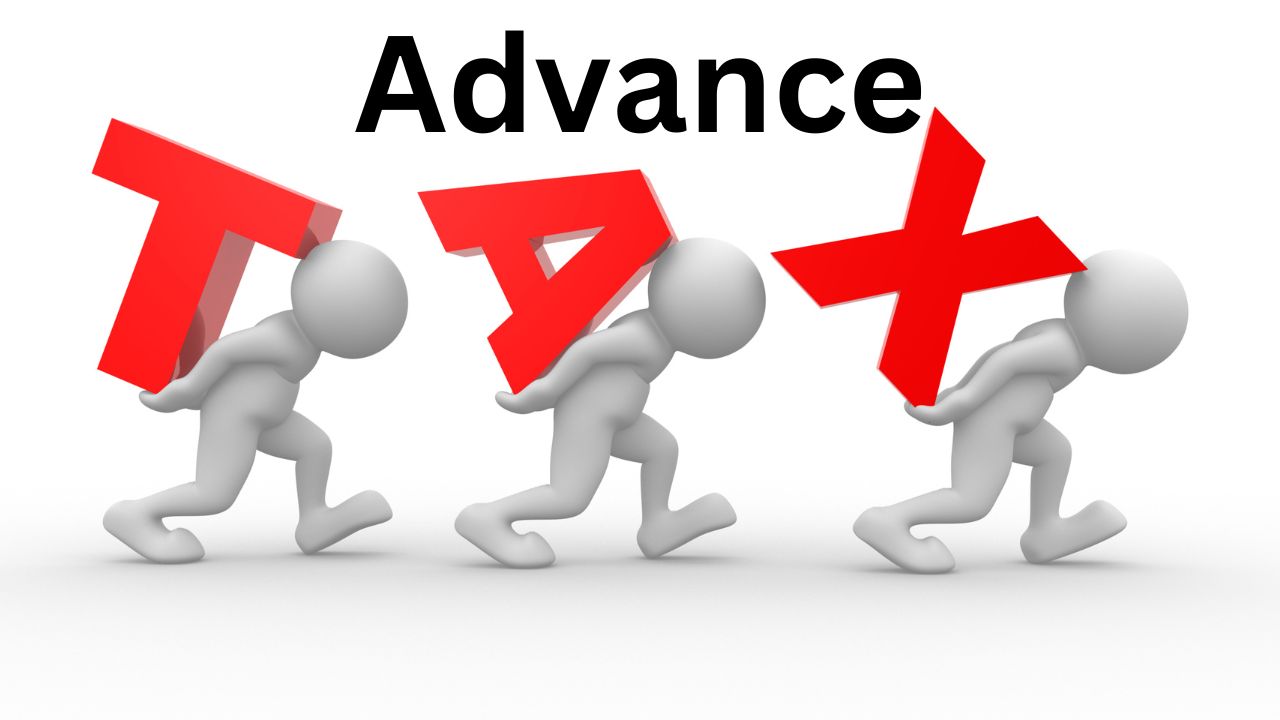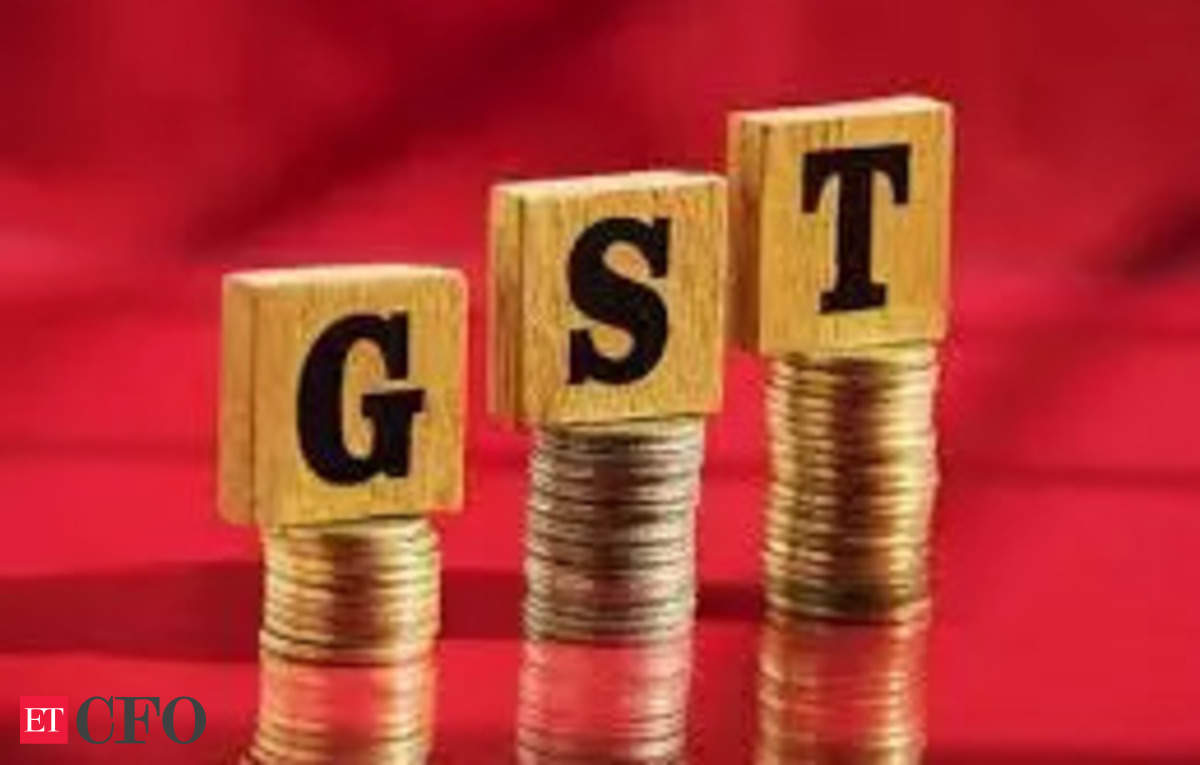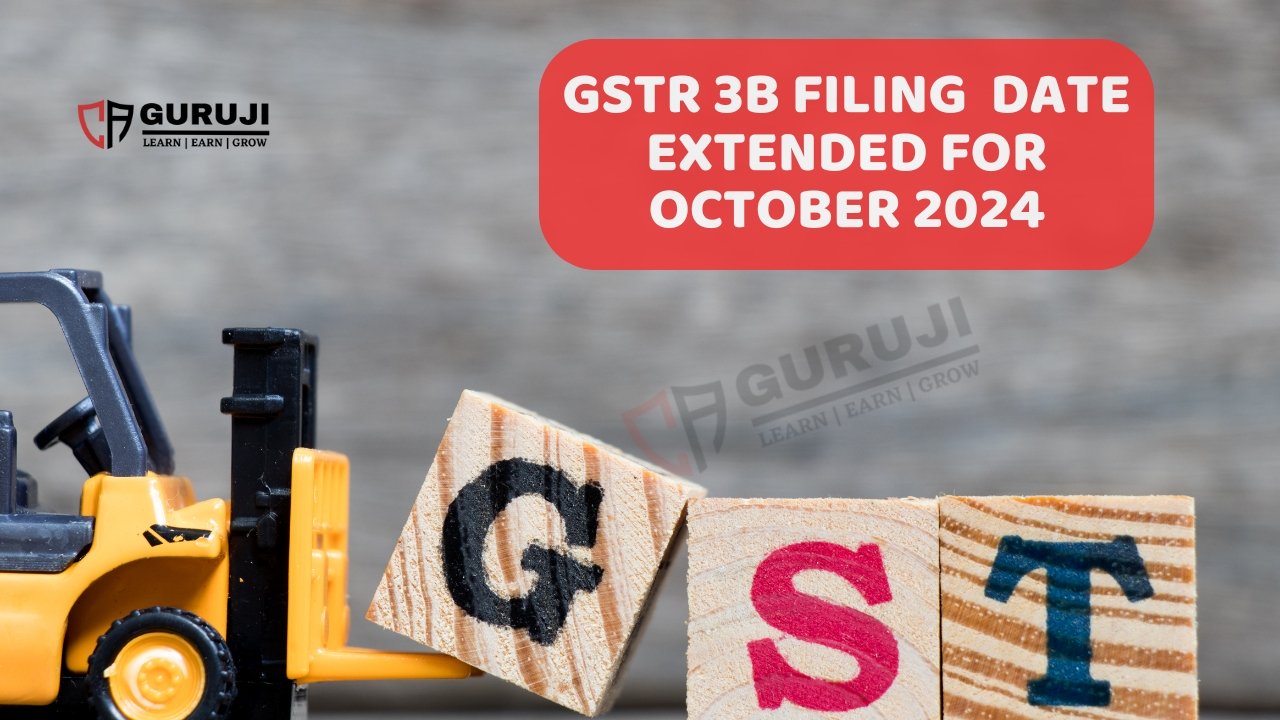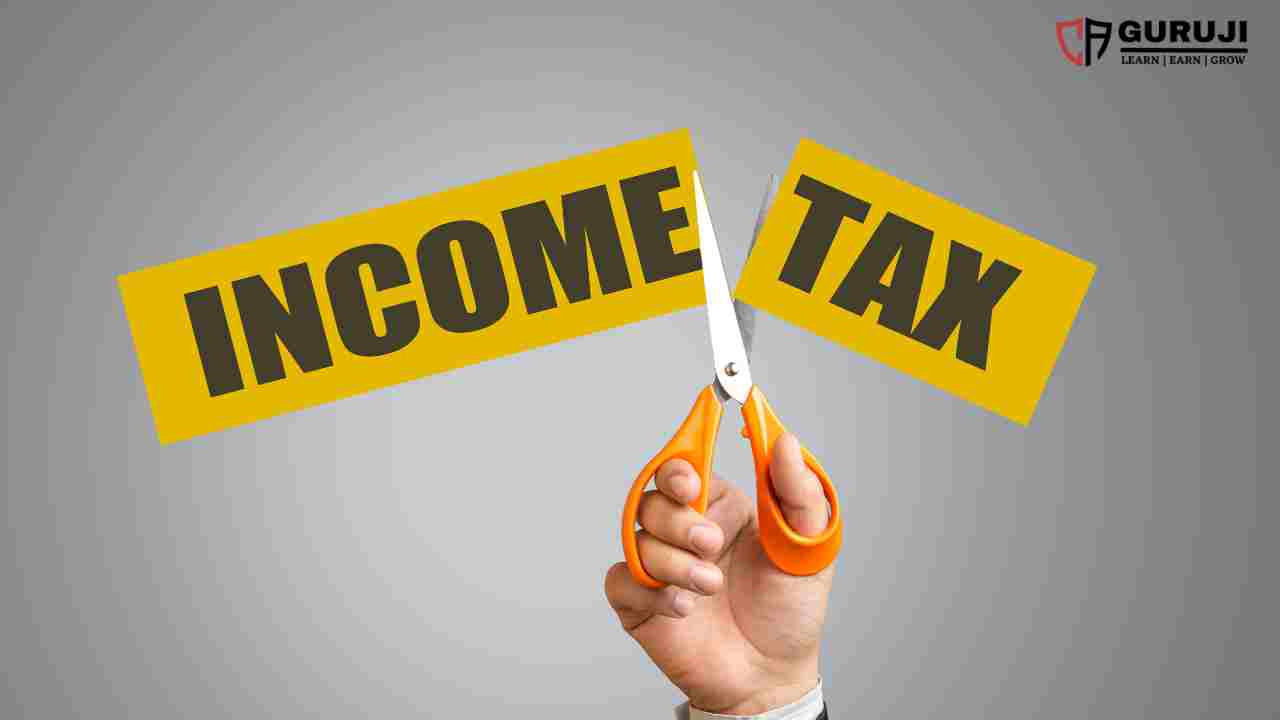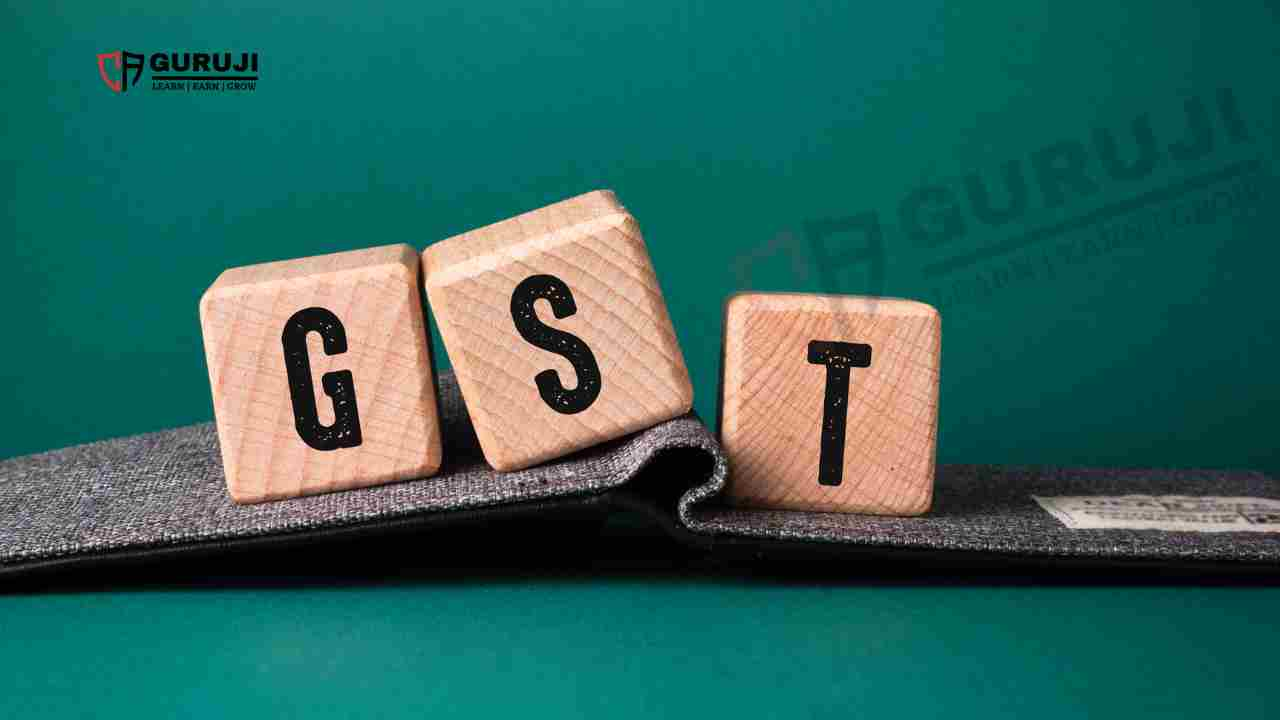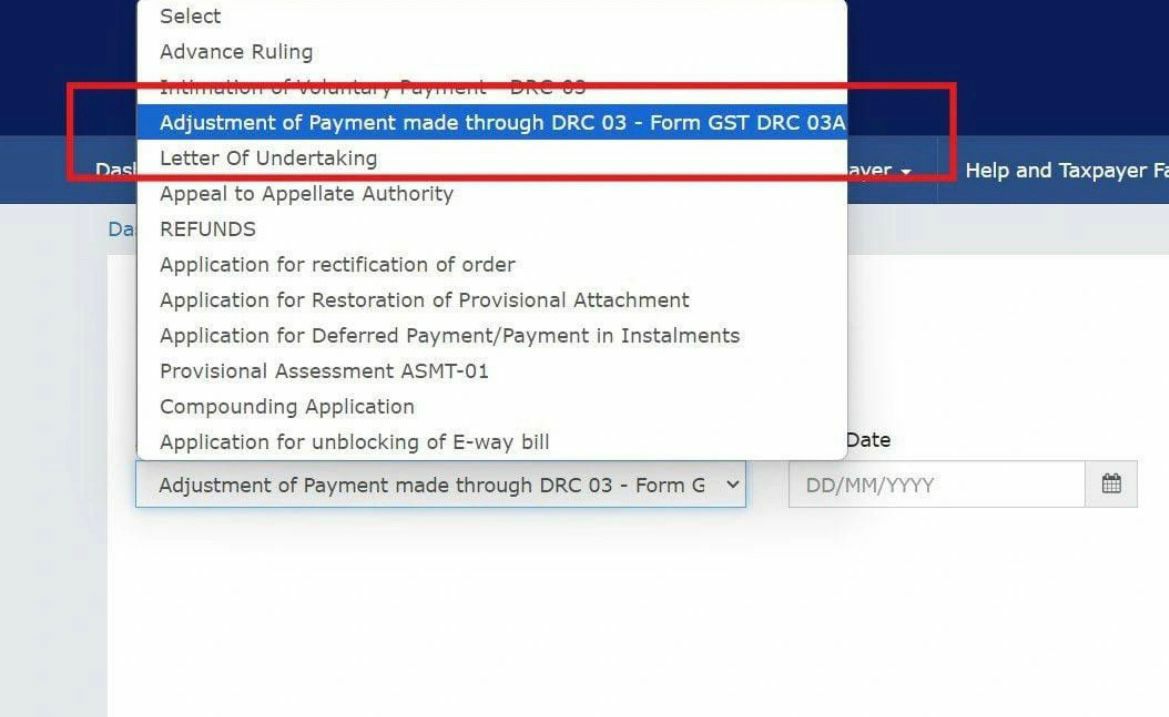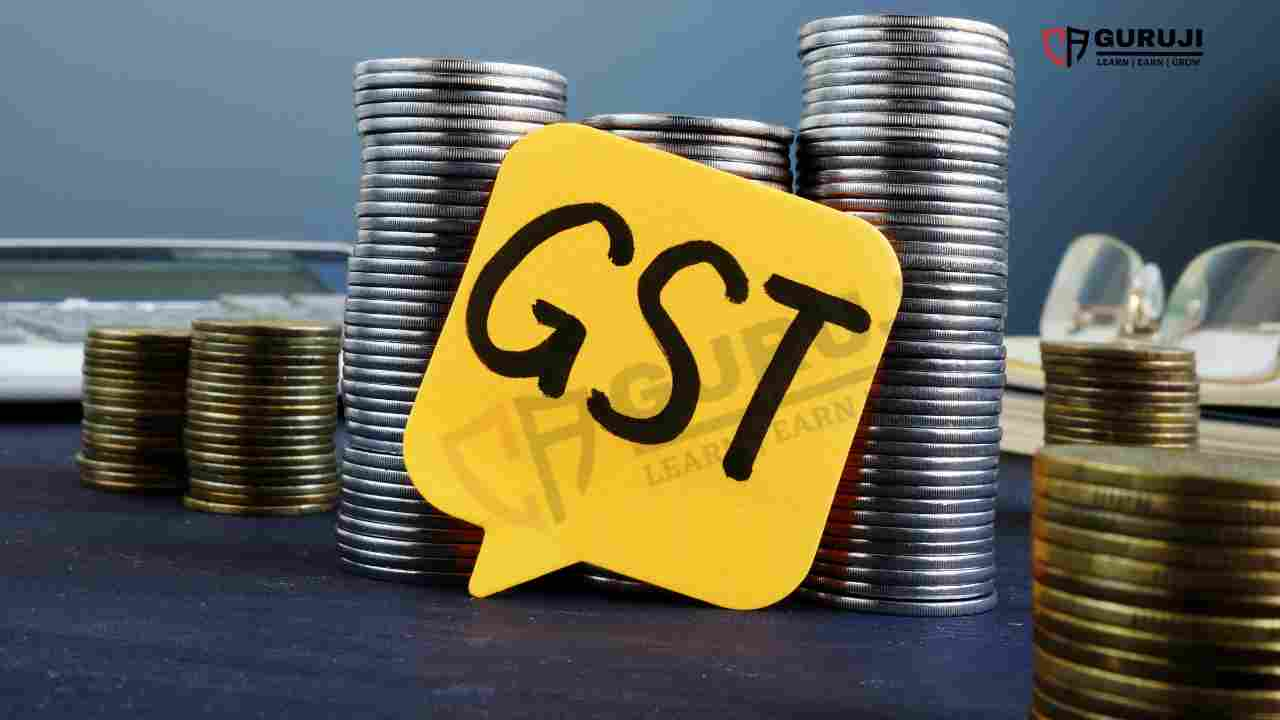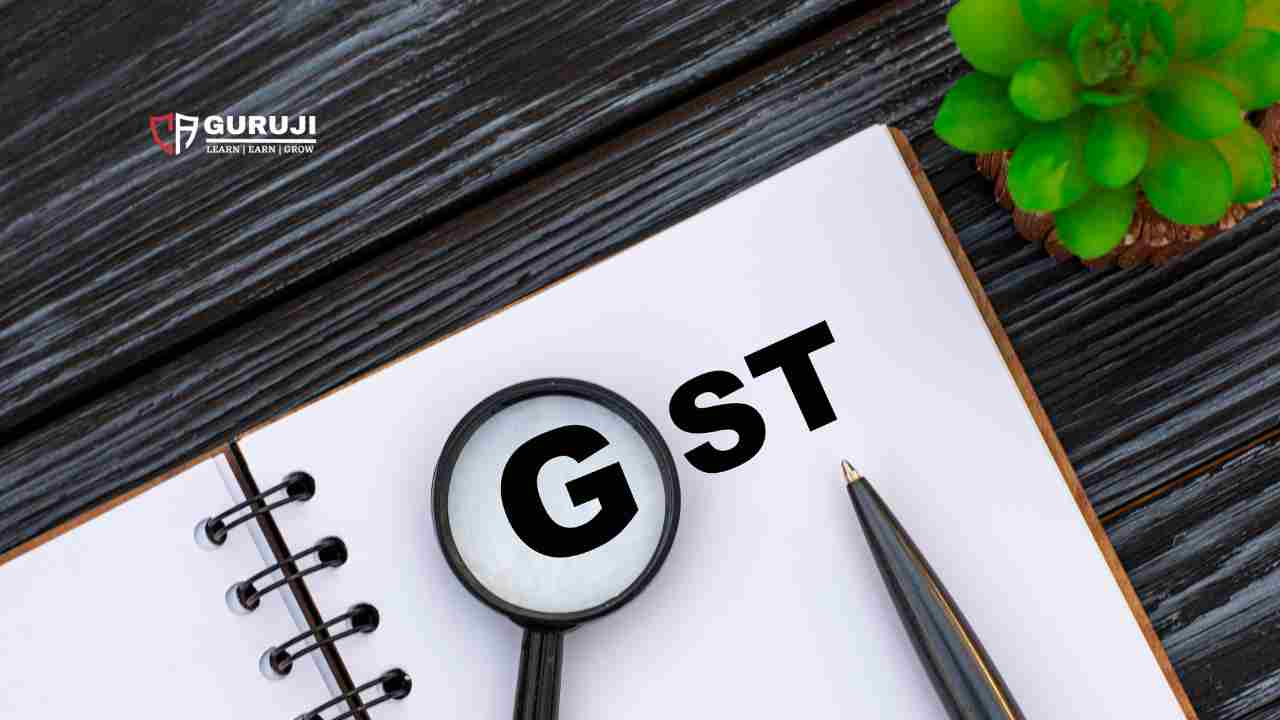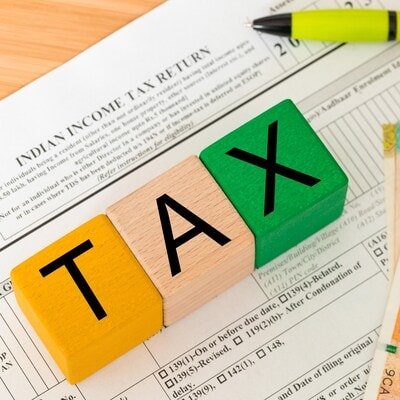Advance tax is a system of paying income tax in installments during the financial year, rather than paying it all at once at the end of the year.
It is a method used by many governments to ensure a steady and regular inflow of tax revenue throughout the year. By paying taxes in advance, the government can avoid cash flow problems and use the funds for various public expenditures and services.
In India, Advance Tax is a significant component of the income tax system and is applicable to certain taxpayers who meet specific criteria. It is also known as “Pay-As-You-Earn” tax, as taxpayers are required to estimate their income and pay taxes in installments during the financial year itself.
Applicability:
As per section 208, Advance Tax is applicable to individuals (including salaried employees, freelancers, professionals, businesses, and corporate entities) whose tax liability for the financial year exceeds a Rs.10000.
The following conditions apply:
Individuals: If the total tax liability for the year (after considering TDS and other tax credits) is Rs. 10,000 or more, they are required to pay Advance Tax.
However, a resident senior citizen (i.e., an individual of the age of 60 years or above during the relevant financial year) not having any income from business or profession is not liable to pay advance tax.
Due Dates and Installments:
For non-corporate taxpayers (individuals, professionals, etc.), the due dates for Advance Tax payments are as follows:
| Due Date | Advance Tax Payment Percentage |
| On or before 15th June | 15% of advance tax |
| On or before 15th September | 45% of advance tax less advance tax already paid |
| On or before 15th December | 75% of advance tax less advance tax already paid |
| On or before 15th March | 100% of advance tax less advance tax already paid |
For taxpayers who have opted for Presumptive Taxation Scheme under sections 44AD & 44ADA – Business Income
| Due Date | Advance Tax Payment Percentage |
|---|---|
| On or before 15th March | 100% of advance tax |
Calculation of Advance Tax:
Taxpayers are required to estimate their total income for the financial year and calculate the tax liability based on the prevailing tax rates and applicable deductions. They need to pay the appropriate installment of Advance Tax as per the due dates mentioned above.
Penalties for Non-Compliance:
Failure to pay Advance Tax or underpayment of the required amount may attract interest under Section 234B and Section 234C of the Income Tax Act, 1961. The interest is levied as per the applicable rate on the amount of underpaid tax and the delay in payment.
Adjustment during Final Assessment:
After the end of the financial year, when the taxpayer files their income tax return, the actual tax liability for the year is computed. Any excess tax paid as Advance Tax is refunded, or the taxpayer can adjust it against future tax liabilities. If there is a shortfall in the tax paid, the taxpayer must pay the remaining amount along with the applicable interest.
Example:
Let’s consider an example of an individual taxpayer named Rahul, who is a freelancer and earns income from various sources, including freelance projects, interest on savings, and capital gains from investments. For the financial year 2023-2024 (assessment year 2024-2025), Rahul estimates his total income and calculates his advance tax liability.
Assumptions:
- Rahul’s estimated total income for the year: Rs. 10,00,000
- Assume Income tax rate applicable to him: 10%
Now, let’s calculate Rahul’s advance tax liability and the installments he needs to pay:
- 1st Installment (Due on 15th June 2023): Estimated Tax Liability: Rs. 10,00,000 * 10% = Rs. 1,00,000 Advance Tax Installment: 15% of Estimated Tax Liability Advance Tax Installment: Rs. 1,00,000 * 15% = Rs. 15,000
- 2nd Installment (Due on 15th September 2023): Estimated Tax Liability: Rs. 10,00,000 * 10% = Rs. 1,00,000 Advance Tax Installment: 45% of Estimated Tax Liability Advance Tax Installment: Rs. 1,00,000 * 45% = Rs. 45,000 (Less Rs.15000 already paid till 1st installment)
- 3rd Installment (Due on 15th December 2023): Estimated Tax Liability: Rs. 10,00,000 * 10% = Rs. 1,00,000 Advance Tax Installment: 75% of Estimated Tax Liability Advance Tax Installment: Rs. 1,00,000 * 75% = Rs. 75,000 (Less Rs.45000 already till in 2nd installment)
- 4th Installment (Due on 15th March 2024): Estimated Tax Liability: Rs. 10,00,000 * 10% = Rs. 1,00,000 Advance Tax Installment: 100% of Estimated Tax Liability Advance Tax Installment: Rs. 1,00,000 * 100% = Rs. 1,00,000 (Less Rs.75000 already paid till 3rd installment)
So, Rahul needs to pay the following advance tax installments:
- 1st Installment (15th June 2023): Rs. 15,000
- 2nd Installment (15th September 2023): Rs. 30,000
- 3rd Installment (15th December 2023): Rs. 30,000
- 4th Installment (15th March 2024): Rs. 25,000
- TOTAL RS.100000
Rahul must make these advance tax payments on or before the respective due dates to comply with the advance tax provisions and avoid any interest or penalty charges. Additionally, he should adjust these payments accurately when filing his income tax return for the financial year 2023-2024 to ensure proper reconciliation with the final tax liability.
How to pay online:
Pay with logging in to the e-Filing portal
Step 1: Log in to the e-Filing portal with your User ID and Password.
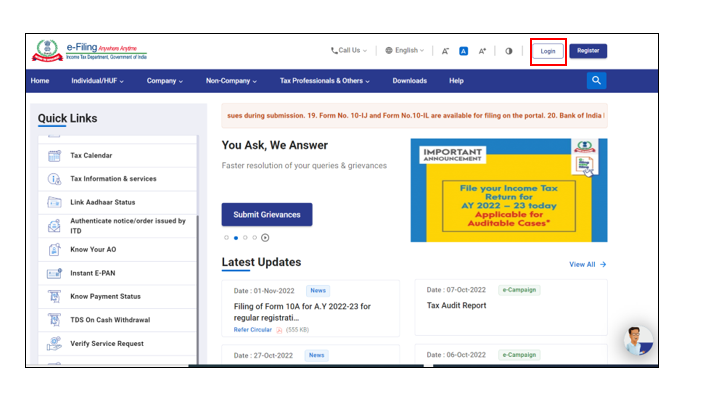
Step 2: On the Dashboard, click e-File > e-Pay Tax. You will be navigated to the e-Pay Tax. On the e-Pay Tax page, click the New Payment option to initiate the online tax payment.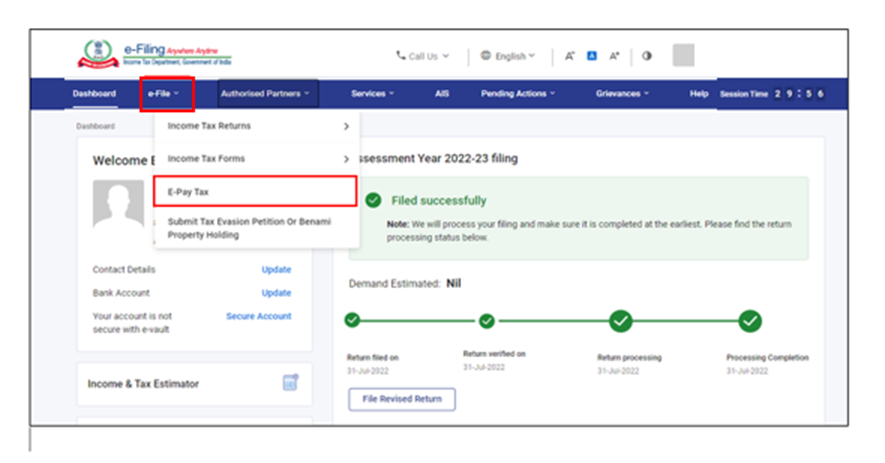
Step 3: On the New Payment page, click Proceed on a tax payment tile applicable to you.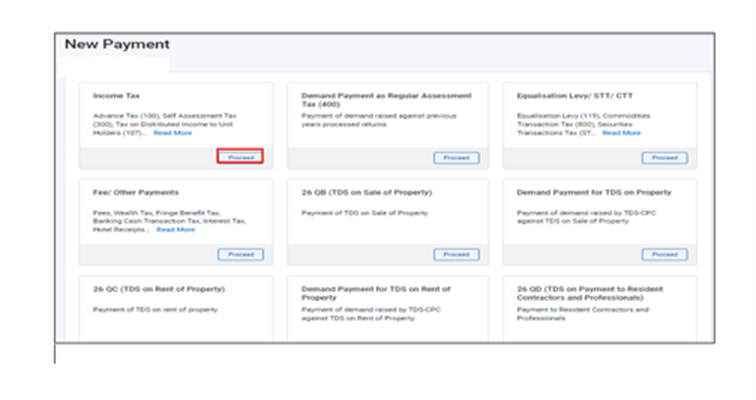
Step 4: After selecting the applicable Tax Payment tile, select Assessment Year, Minor head, other details (as applicable) and click Continue.

Step 5: On the Add Tax Breakup Details page, add the breakup of total amount of tax payment and click Continue.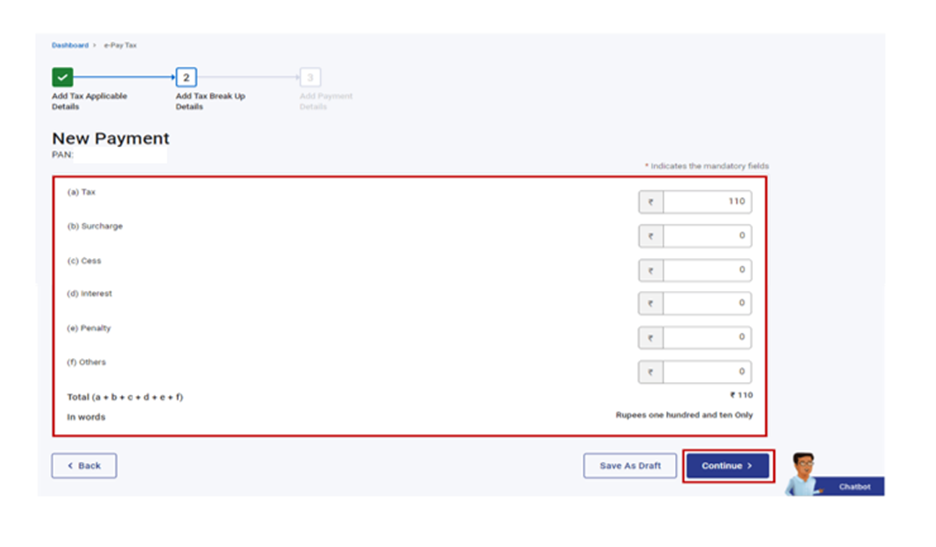
Step 6: In the Select Payment Mode page, select Payment Gateway mode and click Continue. 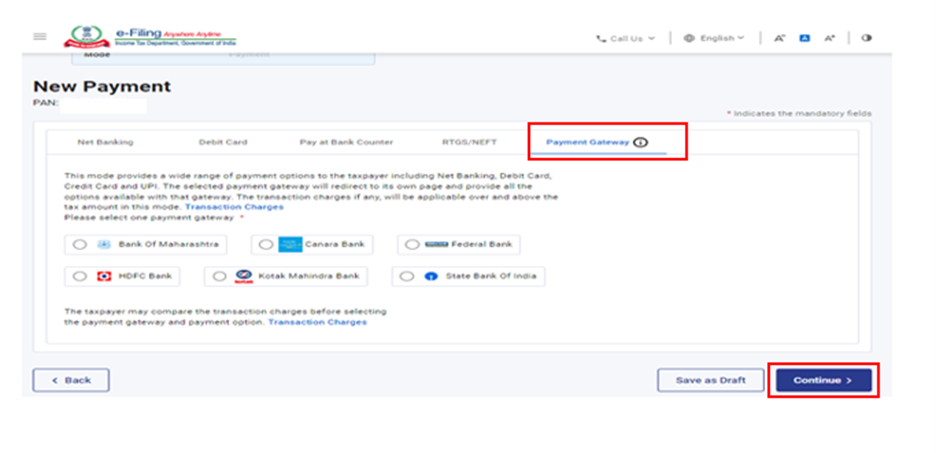
Step 7: In the Preview and Make Payment page, verify the details and tax break up details and click Pay Now.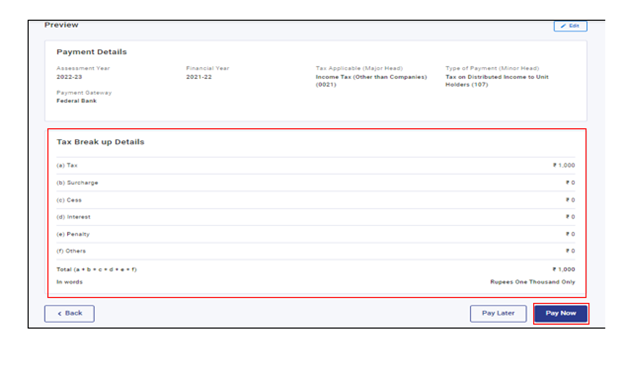
Step 8: Read and select the terms and conditions and click Submit to Bank. (You will be redirected to the website of Payment Gateway where you can login or enter Net Banking/ Debit / Credit Card / UPI details and make the payment). You may compare transaction charges (as per Annexure 1) of the five payment gateways before selecting the payment option.
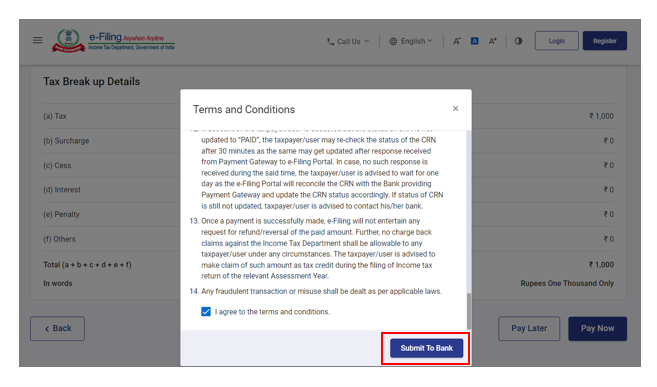
Note: After successful payment, you will receive a confirmation e-Mail and an SMS on the e-Mail ID and Mobile number registered with the e-Filing portal. Once the payment is successful, details of payment and Challan Receipt are available under Payment History Tab on the e-Pay Tax page.
Pay without logging in to the e-Filing portal – Pre-Login Service
Step 1: Go to the e-Filing portal www.incometax.gov.in and click e-Pay Tax.
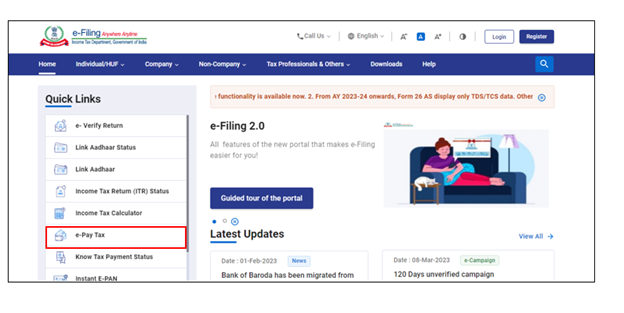
Step 2: On the e-Pay Tax page, fill the required details and click Continue.
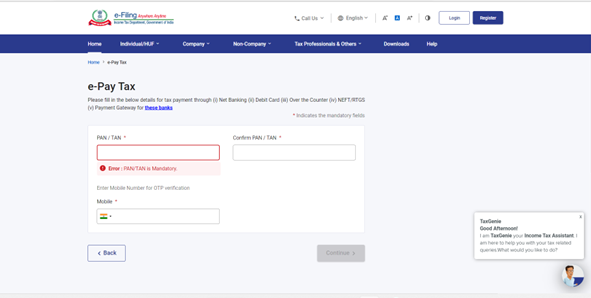
Step 3: On the OTP Verification page, enter the 6-digit OTP received on the mobile number entered in Step 2 and click Continue.
Step 4: After OTP verification, a success message with your PAN/TAN and masked name will be displayed. Click Continue to proceed.
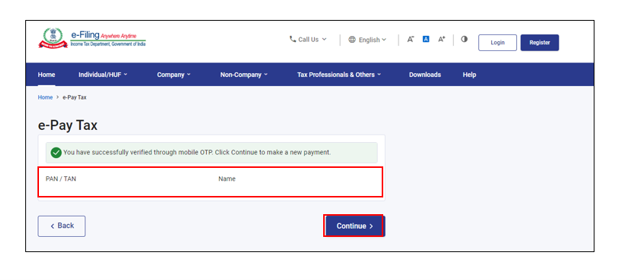
Step 5: On the e-Pay Tax page, click Proceed on a tax payment category that applies to you.
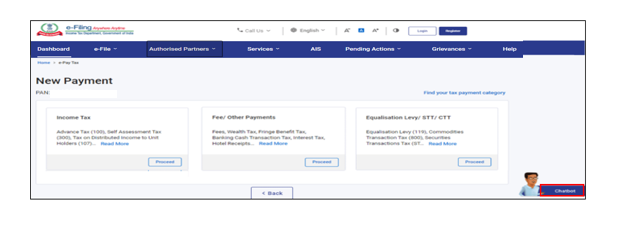
Step 6: After selecting the applicable Tax Payment tile, select Assessment Year, Minor head, other details (as applicable) and click Continue.

Step 7: On the Add Tax Breakup Details page, add the breakup of total amount of tax payment and click Continue.
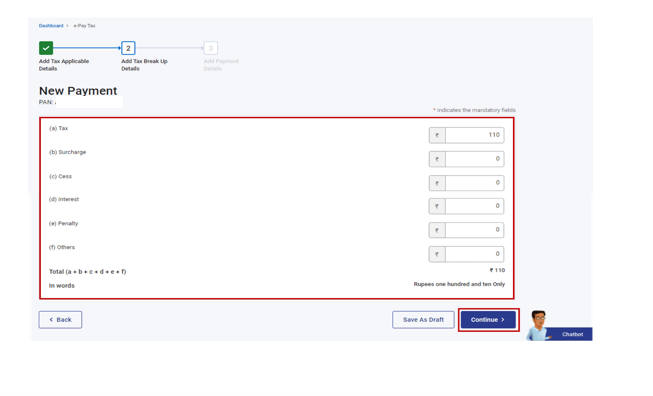
Step 8: In the Select Payment Mode page, select Payment Gateway mode and click Continue.
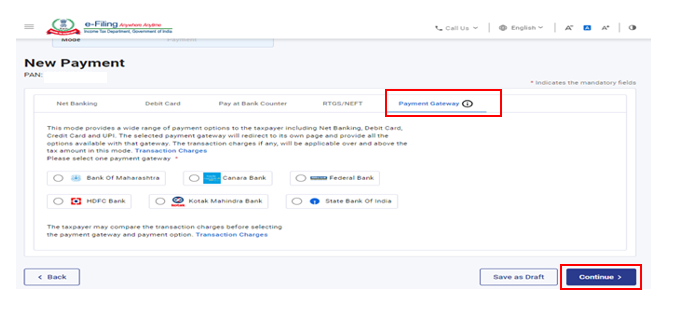
Step 9:In the Preview and Make Payment page, verify the details and tax break up details and click Pay Now.
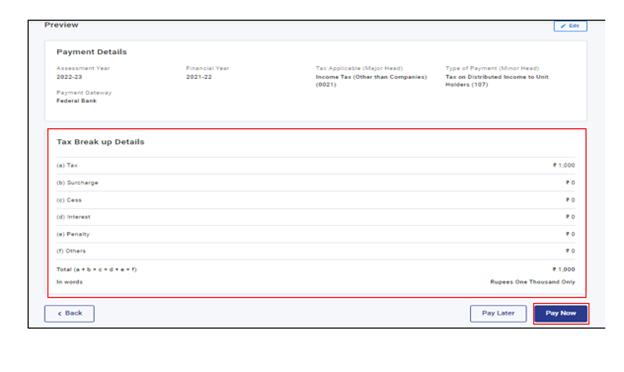
Step 10: Read and select the terms and conditions and click Submit to Bank. (You will be redirected to the website of Payment Gateway where you can login or enter Net Banking/ Debit / Credit Card / UPI details and make the payment). You may compare transaction charges (as per Annexure 1) of the five payment gateways before selecting the payment option.
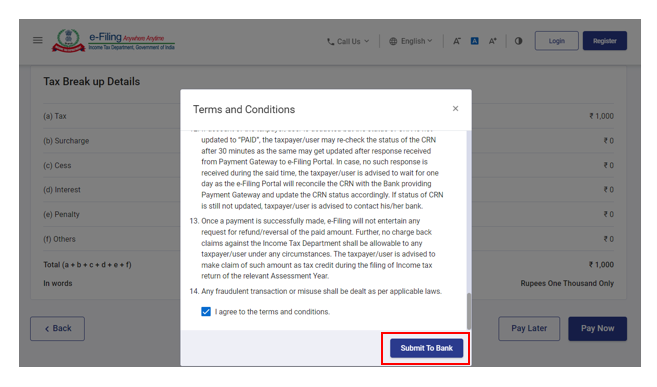
FAQs on Advance Tax Payment:
When should I pay advance tax?
If your tax liability for a year after reducing TDS exceeds Rs 10,000, you will be liable for payment of advance tax.
I have made a mistake in Advance tax challan. How can I rectify the mistake made in Advance tax payment?
Made a mistake in your tax payment challan? Do not worry! You can now correct it easily. The Income Tax Department has recently launched online challan correction feature, where you can make changes to:
- assessment year,
- major head and
- minor head [100 (Advance tax), 300 (self-assessment tax), and 400 (demand payment as regular assessment tax)]
Changes to the assessment year must be made within 7 days of payment and changes to major head and minor head can be made within 30 days of payment.
How to use challan correction feature?
Follow these steps to make corrections to tax challan:
- Log in to the e-filing ITR portal
- Select “Create Challan Correction Request” on the webpage
- Choose the correction type:
- assessment year
- major head
- minor head
- Enter either the Assessment Year or Challan Identification Number (CIN)
- Depending on your choice, view either specific CIN details or a list of challans for the chosen Assessment Year. Choose the relevant challan for correction.
- Input the correct information
- Verify the correction using Aadhaar OTP, Digital Signature Certificate (DSC), or Electronic Verification Code (EVC) through net-banking, Demat, or bank account.
- Once the correction is successfully verified, you will receive a success message along with a transaction ID. Keep the transaction ID for tracking the status of your correction request.
Is an NRI liable for payment of advance tax?
An NRI, who has an income accruing in India in excess of Rs 10,000, is liable for payment of advance tax.
I am a senior citizen with pension and interest income. Should I pay advance tax?
Resident senior citizens not having income from business or profession are not liable for advance tax.
Will I be penalized if I do not pay advance tax?
Non payment of advance tax will result in levy of interest under 234B and 234C of the Income tax Act, 1961.
Can I claim deduction under 80C while estimating income for determining my advance tax?
Yes. You can consider all these deductions while estimating your income for the year for computing your advance tax liability.
What happens if I miss the deadline for payment of the fourth installment of my advance tax i.e. on 15 March
You can still go ahead with payment of advance tax on or before the 31 March of the year. Such payment will still be treated as advance tax only.
How do I make an advance tax payment?
Advance tax payment is made using Challan 280 just like any other regular tax payment. You may read our detailed article on online payment of income tax.
Why should advance tax payments be made?
Advance tax payments benefit both the government and the individual/organisation paying it. From the government’s perspective, it provides a continuous flow of income throughout the year. From the individual/organisation’s perspective, it reduces the year-end burden of paying taxes in a lump sum. Non-payment of advance tax could result in the taxpayer being liable to interest under the Income Tax law. Hence, timely payments of advance tax should be made.
How to check advance tax payment status?
To check the status of your advance tax payment challan, go to https://tin.tin.nsdl.com/oltas/index.html. Select CIN (Challan Identification Number) Based View. Then enter the required details being asked for, in order to view the status. You can also check the list of advance tax payments made by logging in to your income tax account at https://www.incometaxindiaefiling.gov.in/home and going to My account -> View Form 26AS (Tax Credit), and entering the financial year and type of view/download.
How to download the advance income tax challan?
To view the advance tax payment challan, go to https://tin.tin.nsdl.com/oltas/index.html. Select CIN (Challan Identification Number) Based View. Enter the required details, and click on ‘View’. Once the challan details are displayed on the screen, you can either print out the same or save a screenshot. Taxpayers can also download the advance tax payment receipt/challan by visiting the website of the bank through which the advance tax payment was made. An option will be available to download the advance payment receipt.
Can I pay advance tax after the due date?
You must pay advance tax before the financial year ends in 4 instalments: 15th June, 15th September, 15th December and 15th March. If advance tax is not paid according to this schedule, then 1% monthly interest will be levied.
Practical Course at: www.cagurujiclasses.com
